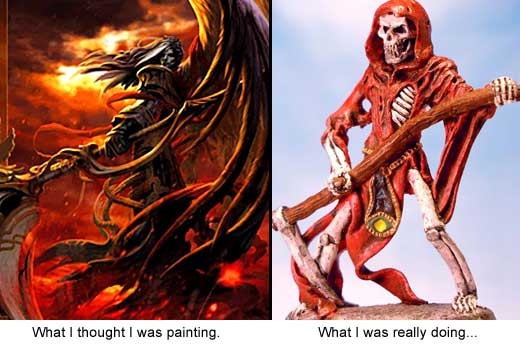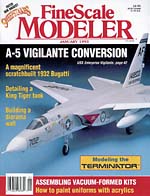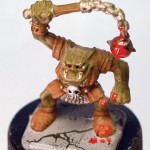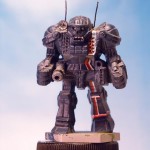Finger Paintings on a Fridge
When I started to paint miniatures for 40K, I thought I knew how I was going to paint these guys. I had 20 years of experience painting model cars, planes, ships and sci-fi vehicles. Mostly larger scales, everything painted with enamel based paints. This should be easy, right? I’m considering this a lesson learned.
My first mini was a plastic orc from Milton Bradley’s board game Heroquest. At the time, I had a Space Ork army (completely unpainted, of course) for WH40K and chose to use these guys to bolster my troops (we proxied a lot back then). I got out my Testors enamels and painted away. I thought it looked pretty good so I painted up a couple of Battletech models. I felt pretty good about them too. Then I got on the internet.
My first realization that minis were very different came when I looked at my Ork Boy and thought it looked a little flat, not as good as large scale models I had done in the past. The scale was the thing – the painting techniques weren’t translating the same at this tiny scale. I wanted to know what else I could do to these little plastic monsters, to look as good as the larger scale models I had so much experience with. So I went online in search of techniques and inspiration.

Instead of inspiration I was struck by how much my minis sucked. No two ways about it. Nearly everything I saw online was so much better than I imagined I could do. I was disheartened. Crushed. Ashamed of my minis! The little plastic guys I was so proud of were pitiful kindergarten finger paintings on a fridge. (No offense to kindergarten kids everywhere.)
Now while I learned how limited my skills were (read: how bad I really was), this was the age of the internet and I took full advantage it. But first, a little digression if I may.
 While I was growing up I subscribed to a magazine called Fine Scale Modeler. This magazine taught me how to prepare, paint, kitbash, detail and weather plastic model kits. Military Modeler and Model Railroad some others. These publications were filled with instructions and photos, showing the process of turning a sprue full of plastic bits into that wonderfully detailed P-38 Lightning or a grungy, worn-out battle-wrecked Panzer tank. They were a big part of what made me an accomplished modeler. I wanted to become as accomplished with miniatures as well.
While I was growing up I subscribed to a magazine called Fine Scale Modeler. This magazine taught me how to prepare, paint, kitbash, detail and weather plastic model kits. Military Modeler and Model Railroad some others. These publications were filled with instructions and photos, showing the process of turning a sprue full of plastic bits into that wonderfully detailed P-38 Lightning or a grungy, worn-out battle-wrecked Panzer tank. They were a big part of what made me an accomplished modeler. I wanted to become as accomplished with miniatures as well.
Digression over.
What I needed was a “Mini-Modeler” magazine. I found it, but not in periodical paper form. The digital domain provided me with the next set of tools and information I needed to “bring my models up to par.” I scoured the web for weeks, looking at pictures, reading tutorials and browsing all manners of works-in-progress. This would be the Saturation phase of the Creative Process for you creatives out there. This is also the part where I start to stand on the shoulders of giants and geniuses who have come before me.
These artists/hobbyists have gone through many, may hours of experimentation and years of practice in the pursuit of this art. If they’ve made the attempt to write down their tips, tricks and techniques they’ve learned, I’m going to listen to them. That saves me a lot of time and heartache. I have the utmost respect for these people as many do this as a hobby and not a day job. I only hope to one day be the inspiration for others as they were/are for me.
One can’t help but come across Cool Mini or Not (CMON from now on) when researching this hobby. I was amazed by a few things after spending some hours roaming this great site. I was firstly awed by the quality and workmanship that is displayed here. Secondly was the sense of community and the willingness of people to share their knowledge, experience and critical eye in helping others learn and excel at this strange, but interesting pastime. You should go bookmark it right now and come back to finish reading this. Go. Now!

